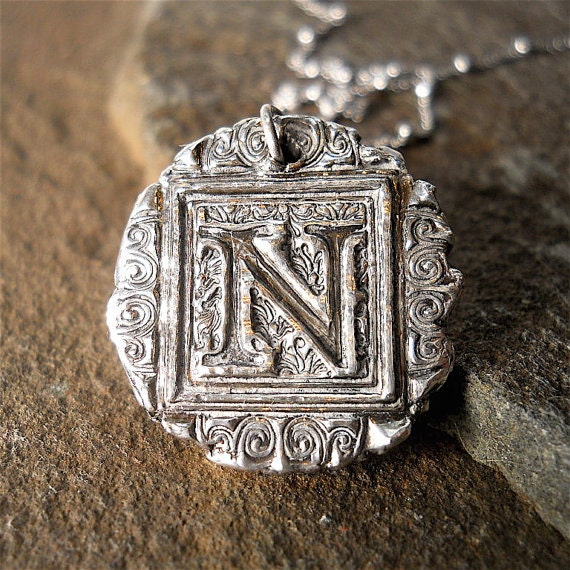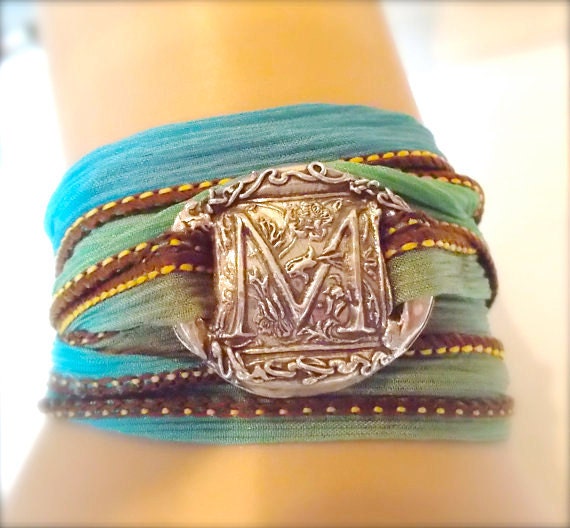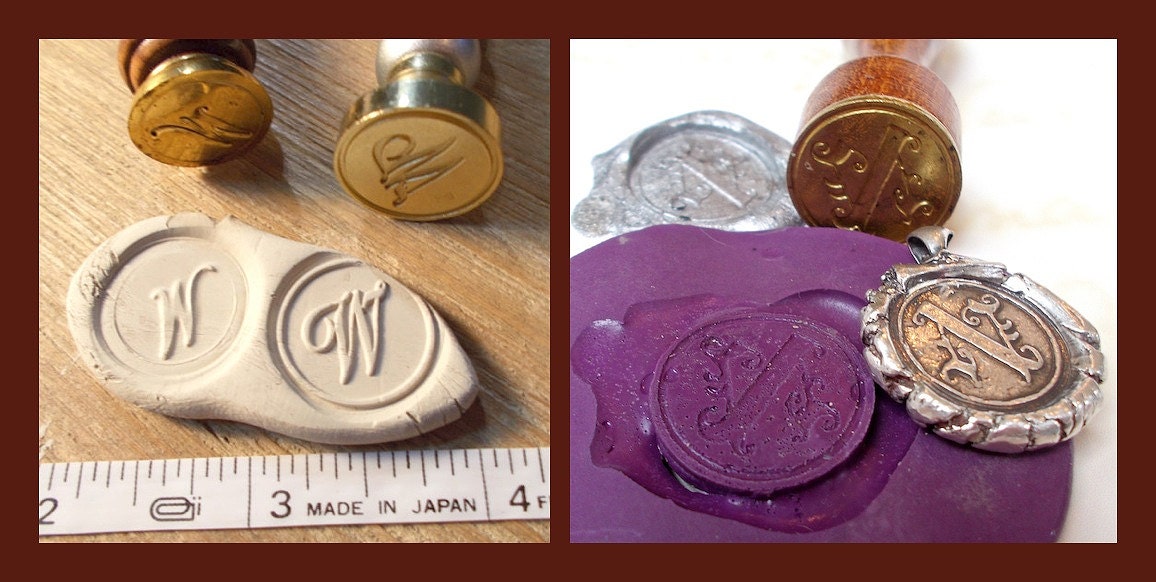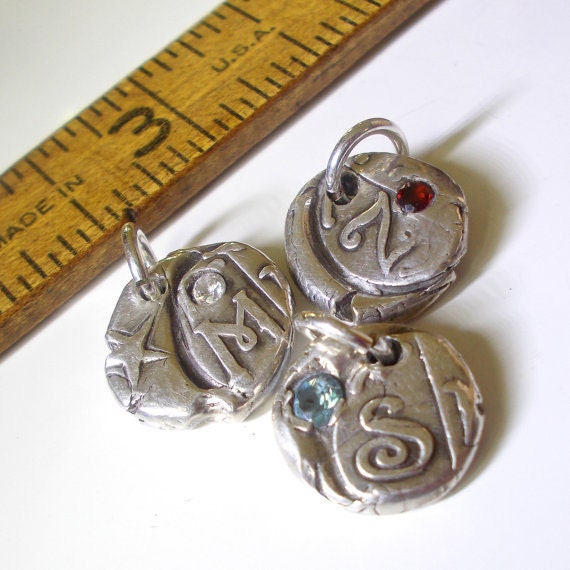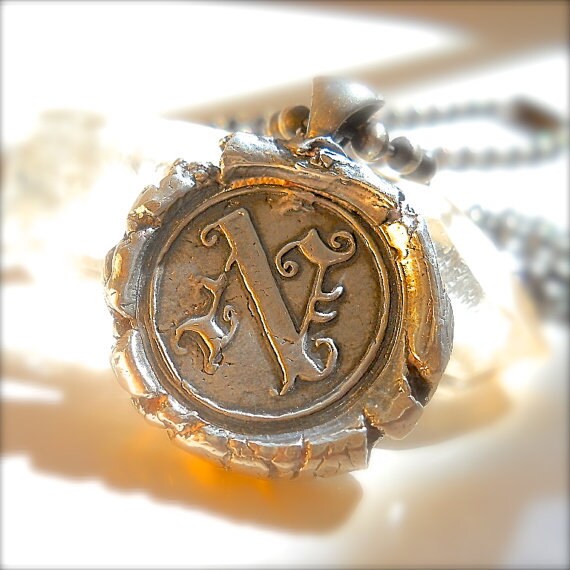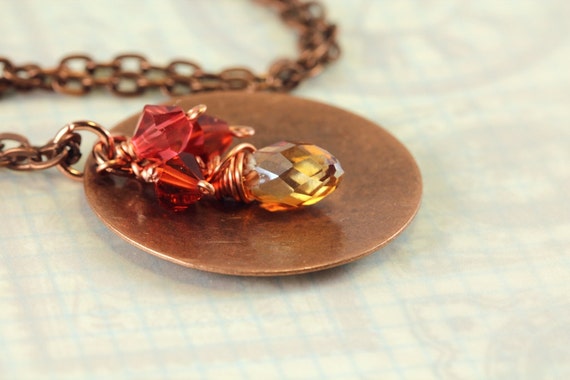Friday, November 22, 2013
Monday, September 9, 2013
I Would Like to Present . . .
A good friend and fellow Jetteam member on Etsy is Norah Downey, owner of the the shop Silver Initial Jewelry http://www.etsy.com/shop/silverinitialjewelry. Norah's unique, one-of-a-kind initials are crafted by hand making use of eco-friendly, recycled silver made with wax seals, many from as early as the 1800's. Her designs are personalized and can be used as pendants, key chains, charms for bracelets, and many more uses. Both men and women can enjoy wearing one of these designs.
One of my favorite designs is this one, which just happens to be displayed with my initial!
This piece is displayed very beautifully as a silk wrap bracelet.
The crafting of these beautiful initials comes from a very interesting history of wax seals. Most of us are familiar with the use of wax seals to seal letters, many of those between lovers. Norah had eloquently described the history of wax seals in a section of her shop. You can read that history here: http://www.etsy.com/shop/SilverInitialJewelry/about/
These are just some examples of wax seals.
Norah has several sizes of initials ranging from petite ones . . .
One of my favorite designs is this one, which just happens to be displayed with my initial!
This piece is displayed very beautifully as a silk wrap bracelet.
The crafting of these beautiful initials comes from a very interesting history of wax seals. Most of us are familiar with the use of wax seals to seal letters, many of those between lovers. Norah had eloquently described the history of wax seals in a section of her shop. You can read that history here: http://www.etsy.com/shop/SilverInitialJewelry/about/
These are just some examples of wax seals.
Norah has several sizes of initials ranging from petite ones . . .
to extra large ones . . .
If you are planning a gift for someone special in your life--or yourself--consider one of these lovely initials. It will be an extra special treat. Silver Initial Jewelry by Norah Downey
Sunday, June 9, 2013
Cleaning Copper Jewelry
With the price of precious metals, especially gold, so high, many fashion-conscious people are turning more and more to other metals for jewelry. Copper and brass are two of the most popular. But as you probably know, copper tarnishes very quickly and soon takes on a dark appearance. Here are some tips for cleaning copper using familiar household goods.
1. Cut a lemon in half and
add a dash of salt to cut side. Rub the lemon over the jewelry piece. You can
also add a dash of salt to some lemon juice (enough juice to coat the piece).
Dip the jewelry into the juice and let it sit for a few minutes. Rinse the
piece off with water and dry it thoroughly with a polishing cloth.
2. Rub your jewelry with a small amount of ketchup or tomato juice. Rinse well and dry with a polishing cloth.
3. Combine equal parts of lemon juice and baking soda to form a paste and rub the paste on your jewelry. Rinse and dry.
4. Sprinkle some Worcestershire sauce on your copper piece. Rinse well and dry thoroughly.
2. Rub your jewelry with a small amount of ketchup or tomato juice. Rinse well and dry with a polishing cloth.
3. Combine equal parts of lemon juice and baking soda to form a paste and rub the paste on your jewelry. Rinse and dry.
4. Sprinkle some Worcestershire sauce on your copper piece. Rinse well and dry thoroughly.
Tuesday, June 4, 2013
Pearls of Wisdom for June Birthday Buying
I love pearls. They are such a classic gem, worn for so many different occasions and appropriate for almost any time. They are ageless, too. Pearls have been worn for centuries, at least as far back as the Roman Empire. The only gem that comes from a living sea creature, the pearl is the number one gem choice for the June birthstone. While natural pearls may be bought at an extremely high price, most pearl jewelry today uses cultured pearls that are created in oyster farms.
Pearl and crystal earrings in my Etsy shop
A very lovely alternate birthstone for June is the moonstone. If you love to see a play of color in gemstones, then you will enjoy the flashes and glints of silvery blue that moonstones radiate from their milky white surface. When the stone is moved back and forth, it almost seems as though the silvery blue rays move also.
A necklace in my shop with moonstones
The third birthstone alternative for June is the Alexandrite gemstone. The Alexandrite is a charming, unusual stone, changing in its colors almost like a chameleon. In natural daylight it appears bluish green while under artificial light it appears violet in color. Natural Alexandrite is very rare and expensive, so most Alexandrite birthstones are manmade and it is very difficult to reproduce the color changing ability of the natural stone.
Here is an Alexandrite ring I found in another Etsy shop.
So if you are shopping for that special person with a June birthday, you have several gems to choose from. A hard choice to make since all three are beautiful in their own way. Happy shopping!
Pearl and crystal earrings in my Etsy shop
A very lovely alternate birthstone for June is the moonstone. If you love to see a play of color in gemstones, then you will enjoy the flashes and glints of silvery blue that moonstones radiate from their milky white surface. When the stone is moved back and forth, it almost seems as though the silvery blue rays move also.
A necklace in my shop with moonstones
The third birthstone alternative for June is the Alexandrite gemstone. The Alexandrite is a charming, unusual stone, changing in its colors almost like a chameleon. In natural daylight it appears bluish green while under artificial light it appears violet in color. Natural Alexandrite is very rare and expensive, so most Alexandrite birthstones are manmade and it is very difficult to reproduce the color changing ability of the natural stone.
Here is an Alexandrite ring I found in another Etsy shop.
So if you are shopping for that special person with a June birthday, you have several gems to choose from. A hard choice to make since all three are beautiful in their own way. Happy shopping!
Thursday, May 16, 2013
Storms in Texas
I'm sure most of you have heard, seen, read about the devastating tornadoes in parts of Texas last night. One of the worst hit Granbury, about 30 miles northeast of Stephenville, destroying homes and killing six people. It was a night of fear in central and north Texas as swirling wall couds, baseball size hail, thunderstorms, and rain danced all over the area. There are still six or seven people missing in Granbury. The tornado that hit there was rated as an EF4--an EF5 is the worst. Here is a video describing the scene.
Wednesday, April 3, 2013
Wowee! Can't believe how long it has been since my last post. Time gets away from you when you're having fun--and getting older! So I think I will finish up my posts on precious metals and move on to other things.
Today I will cover the gold-colored metals, specifically karat gold, gold filled, and gold plated.
Karat gold is what most people would consider "real" or "solid" gold in the jewelry business. The term karat refers to the amount of gold that is actually present. Higher numbers mean, of course, higher gold content. Here is a chart that gives karat and how much pure gold is contained in the item.
24 karat is 100% pure gold. This would be found in bullion bars and coins, only rarely in jewelry. The higher the gold content, the softer the metal, so pure gold in jewelry would not be very durable.
18 karat is 75% gold and 25% other metals. This is usually the highest gold content found in jewelry.
14 karat is 58.5% gold and 41.5% other metals, also used in jewelry.
10 karat is 41.7% gold and 58.3% other metals, and is usually the lowest karat used in jewelry.
A piece of jewelry made with karat gold will be stamped with the gold amount, usually as 18k, 14k, and 10k.
Of course, karat gold jewelry is usually expensive and has become more so over the past couple of years.
A less expensive form of gold is often used by jewelers, and by us handmade jewelry makers, to help keep the cost of jewelry down to an affordable price range, yet still be durable. That form is called gold filled.
Gold filled components must contain gold that is at least 1/20 the weight of the component. The gold is mechanically heated and bonded to base metal such as brass and is much more durable and long-lasting than gold plated. Like karat gold, gold filled metal will not tarnish. The life span of a jewelry piece made with gold filled metal can be anywhere from 5 to 30 years, depending on how long and how often it is worn and the care given to it. I personally have several pieces of jewelry, including a charm bracelet, made with gold filled metal that are over 40 years old and still as beautiful as the day I received them.
Another economical replacement for karat gold is vermeil (pronounced "vermay"). which is formed by taking sterling silver and coating it with gold that is at least 10 karat and 2.5 microns thick.
Vermeil is very useful for persons with metal allergies, since its base is sterling silver and does not contain nickel, brass, copper, or other metals which commonly cause allergic reactions.
Finally, most costume and/or everyday jewelry items contain gold plated metal. Gold plated means that a microscopic film of gold is adhered to base metal, usually using an electroplating, or dipping, method. Gold plated metal will eventually chip and wear off, and purchasers should be aware that the metal in their jewelry pieces will not last forever.
Cleaning gold jewelry is best accomplished by washing or rinsing your pieces in warm, sudsy water and drying with a soft, lint-free cloth. Karat gold, gold filled, and vermeil will not tarnish, so dipping in a commercial jewelry cleaner is not needed. With plated metal you need to take care not to expose your jewelry to chemicals, bumps, and scratches, as this will cause the plating to wear off more quickly. Just use the sudsy water and soft cloth method to clean your gold plated pieces.
Regardless of what kind of metal is used in your jewelry, the care that you give your pieces will extend their lifetime. Exposure to chemicals, including chlorine in swimming pools, should be avoided, and wearing jewelry while performing manual labor or exercising is not a good idea. So take care of your jewelry, no matter how expensive it is, and it will give you many years of wearing enjoyment.
Today I will cover the gold-colored metals, specifically karat gold, gold filled, and gold plated.
Karat gold is what most people would consider "real" or "solid" gold in the jewelry business. The term karat refers to the amount of gold that is actually present. Higher numbers mean, of course, higher gold content. Here is a chart that gives karat and how much pure gold is contained in the item.
24 karat is 100% pure gold. This would be found in bullion bars and coins, only rarely in jewelry. The higher the gold content, the softer the metal, so pure gold in jewelry would not be very durable.
18 karat is 75% gold and 25% other metals. This is usually the highest gold content found in jewelry.
14 karat is 58.5% gold and 41.5% other metals, also used in jewelry.
10 karat is 41.7% gold and 58.3% other metals, and is usually the lowest karat used in jewelry.
A piece of jewelry made with karat gold will be stamped with the gold amount, usually as 18k, 14k, and 10k.
Of course, karat gold jewelry is usually expensive and has become more so over the past couple of years.
A less expensive form of gold is often used by jewelers, and by us handmade jewelry makers, to help keep the cost of jewelry down to an affordable price range, yet still be durable. That form is called gold filled.
Gold filled components must contain gold that is at least 1/20 the weight of the component. The gold is mechanically heated and bonded to base metal such as brass and is much more durable and long-lasting than gold plated. Like karat gold, gold filled metal will not tarnish. The life span of a jewelry piece made with gold filled metal can be anywhere from 5 to 30 years, depending on how long and how often it is worn and the care given to it. I personally have several pieces of jewelry, including a charm bracelet, made with gold filled metal that are over 40 years old and still as beautiful as the day I received them.
Another economical replacement for karat gold is vermeil (pronounced "vermay"). which is formed by taking sterling silver and coating it with gold that is at least 10 karat and 2.5 microns thick.
Vermeil is very useful for persons with metal allergies, since its base is sterling silver and does not contain nickel, brass, copper, or other metals which commonly cause allergic reactions.
Finally, most costume and/or everyday jewelry items contain gold plated metal. Gold plated means that a microscopic film of gold is adhered to base metal, usually using an electroplating, or dipping, method. Gold plated metal will eventually chip and wear off, and purchasers should be aware that the metal in their jewelry pieces will not last forever.
Cleaning gold jewelry is best accomplished by washing or rinsing your pieces in warm, sudsy water and drying with a soft, lint-free cloth. Karat gold, gold filled, and vermeil will not tarnish, so dipping in a commercial jewelry cleaner is not needed. With plated metal you need to take care not to expose your jewelry to chemicals, bumps, and scratches, as this will cause the plating to wear off more quickly. Just use the sudsy water and soft cloth method to clean your gold plated pieces.
Regardless of what kind of metal is used in your jewelry, the care that you give your pieces will extend their lifetime. Exposure to chemicals, including chlorine in swimming pools, should be avoided, and wearing jewelry while performing manual labor or exercising is not a good idea. So take care of your jewelry, no matter how expensive it is, and it will give you many years of wearing enjoyment.
Tuesday, January 22, 2013
Metal Choices for Jewelry, Part II
Most of my morning was spent in a jury pool in our district courtroom--waiting, and waiting, and waiting. Finally, after being told there were two criminal trials taking place this week, about 45 were selected for the jury pool for today's trial. The remainder of us (only about 30) were instructed to return on Thursday, when a jury will be selected from among us for the second trial. Hmmm--12 out of 45 versus 12 out of 30. Looks like my chances of being selected have just gone up! Anyway, looks like a short trial and no jury sequestering! So if I get picked, I'll gladly do my civic duty and serve.
Yesterday I started a blog on metals that are commonly used in jewelry making, beginning with silver, or white, colored metals. I did omit one metal that is commonly used in less expensive jewelry, and that is silver plated metals, and a relative newcomer to the metal world, silver filled.
Silver plated metals are base metals that have a thin, almost microscopic silver coating on them that is usually applied electrically. If the coating is actually silver, the item will match the color of sterling silver. Cheaper costume jewelry may have white-plated metal, which is a grayer color. Some metals are also coated with rhodium, which is a brighter, more silvery color. The base metals that are commonly used in silver plated components are pewter (or pewter alloy), brass, and stainless steel. Like sterling silver, silver plated metal will tarnish, and, because of the thin coating, will usually lose their silver color.
The advantage of silver plate over other silver metals is, of course, its cost. However, do not expect most jewelry with silver plated components to retain its shiny, silvery appearance for a long period of time. These jewelry pieces should be purchased with the understanding that they may not be lifetime pieces, especially if worn often. This is not to say that all silver plated components are bad. I have many beautiful pieces of jewelry with silver or gold plate that I have had for many, many years and they still look almost as good a new. You can pick up a catalog of a famous Texas department store and find jewelry priced in the hundreds of dollars that uses silver (or gold) plated materials. Not all plated metals are created equal, and some have more lasting power than others. So don't shy away from buying jewelry just because of the silver plated materials. Just be aware that it probably won't have the long life that sterling silver, white gold, and platinum have. If you pay $10 for a necklace, chances are $10 worth of wear is what you'll get.
A relative newcomer has appeared on the jewelry scene in response to the rising costs of sterling silver and gold--silver filled. Many of you will recognize the term "gold filled' which has been around for many years. Silver filled metal is basically the same as gold filled, sterling silver that is bonded using heat and pressure to a base metal. The layer of sterling silver is hundreds of times thicker than that used in plating and it does not flake off like silver plate. Also, the appearance is identical to sterling silver, it can be bent and manipulated just like sterling silver, and it is just as long lasting as sterling silver. As of right now, there is no industry standard for silver filled, but most reputable suppliers sell material that is 1/10th sterling silver by weight.
The chief advantage of silver filled over sterling silver metal is the cost--silver filled is 40-60% less than sterling silver.
I have been using some silver filled findings, beads, and wire over the past year and have to say I am very happy with the results. Hopefully as more and more jewelry designers begin to make use of it, more will become available through the suppliers.
In the next post I will talk about the yellow, or gold, colored metals.
Yesterday I started a blog on metals that are commonly used in jewelry making, beginning with silver, or white, colored metals. I did omit one metal that is commonly used in less expensive jewelry, and that is silver plated metals, and a relative newcomer to the metal world, silver filled.
Silver plated metals are base metals that have a thin, almost microscopic silver coating on them that is usually applied electrically. If the coating is actually silver, the item will match the color of sterling silver. Cheaper costume jewelry may have white-plated metal, which is a grayer color. Some metals are also coated with rhodium, which is a brighter, more silvery color. The base metals that are commonly used in silver plated components are pewter (or pewter alloy), brass, and stainless steel. Like sterling silver, silver plated metal will tarnish, and, because of the thin coating, will usually lose their silver color.
The advantage of silver plate over other silver metals is, of course, its cost. However, do not expect most jewelry with silver plated components to retain its shiny, silvery appearance for a long period of time. These jewelry pieces should be purchased with the understanding that they may not be lifetime pieces, especially if worn often. This is not to say that all silver plated components are bad. I have many beautiful pieces of jewelry with silver or gold plate that I have had for many, many years and they still look almost as good a new. You can pick up a catalog of a famous Texas department store and find jewelry priced in the hundreds of dollars that uses silver (or gold) plated materials. Not all plated metals are created equal, and some have more lasting power than others. So don't shy away from buying jewelry just because of the silver plated materials. Just be aware that it probably won't have the long life that sterling silver, white gold, and platinum have. If you pay $10 for a necklace, chances are $10 worth of wear is what you'll get.
A relative newcomer has appeared on the jewelry scene in response to the rising costs of sterling silver and gold--silver filled. Many of you will recognize the term "gold filled' which has been around for many years. Silver filled metal is basically the same as gold filled, sterling silver that is bonded using heat and pressure to a base metal. The layer of sterling silver is hundreds of times thicker than that used in plating and it does not flake off like silver plate. Also, the appearance is identical to sterling silver, it can be bent and manipulated just like sterling silver, and it is just as long lasting as sterling silver. As of right now, there is no industry standard for silver filled, but most reputable suppliers sell material that is 1/10th sterling silver by weight.
The chief advantage of silver filled over sterling silver metal is the cost--silver filled is 40-60% less than sterling silver.
I have been using some silver filled findings, beads, and wire over the past year and have to say I am very happy with the results. Hopefully as more and more jewelry designers begin to make use of it, more will become available through the suppliers.
In the next post I will talk about the yellow, or gold, colored metals.
Monday, January 21, 2013
Metal Choices for Jewelry
In talking with customers, there seems to be some confusion over the different types of metals that are commonly used in jewelry making. I'll try to clear up some of that confusion by describing metal choices that are available, their pros and cons, and even throw in a little information on the care of metals. I'll divide this up into more than one post, since there is so much information about so many kinds of metals.
SILVER METALS--Fine Metals
There are many metals and alloys that are commonly used in jewelry that have the look of a silver, or white, color. The first metal that most people think of is sterling silver. Sterling silver is actually an alloy of pure, or fine, silver. Making up sterling silver is 92.5% silver and 7.5% other metal, usually and most commonly copper. Sterling silver is much harder and more durable than pure silver, which is very soft and malleable. The small percentage of copper does not change the look of the silver, and actually has little effect on its value. Most sterling silver will be stamped with a mark, which is usually .925, sterling, sterling silver, or ster.
Sterling silver is not cheap, so expect to pay a bit more for jewelry that is made of or has sterling silver parts, beads, or findings. Of course, the higher price is offset by the fact that sterling silver is lasting, and with proper care, will endure for a lifetime and will become a family heirloom.
Sterling silver should be cleaned regularly to prevent tarnish and stored away from other metals in a cloth or plastic bag, or kept in a separate compartment in your jewelry chest. Anti-tarnish paper strips made by 3M can be purchased and placed in the bag or compartment along with your silver piece to help prevent tarnish and erosion. Silver should be cleaned with a soft polishing cloth. This is the best method of cleaning sterling silver that is used in jewelry. There are polishing creams and liquids on the market, but be careful when using them. If your silver has any dark, or oxidized, places on it that are put there to shade or emphasize the design, the creams and liquids will remove this oxidation, so unless you want your sterling silver to be totally shiny and bright, stick with the polishing cloth. And clean often. Don't wait for tarnish to build up, but rather remove it as soon as you can see it.
Another fine metal that has a silver appearance is white gold. White gold is actually gold with a white alloy added, such as nickel, palladium, platinum, and manganese. It is then plated with a rhodium metal, which gives it the white, shiny look. White gold does not tarnish like sterling silver, but it is much, much more expensive since it does contain, after all, gold. If you have been watching the price of gold and silver on the market over the past couple of years, you know that gold just keeps increasing in price, so if you want white gold in your jewelry, expect to pay much higher prices.
The most precious, and costly, of all the silver metals is platinum. Unlike gold, which is mixed with other metals before it is cast into jewelry settings, platinum is used in a near pure form--about 95% pure, in fact. Its color is naturally white, so no mixing with other metals or plating with rhodium is needed to give platinum its beautiful shine. Platinum is also heavier than gold and is very durable. It is, however, very expensive--about twice the price of gold!--and is usually used for serious jewelry pieces, such as engagement rings, if you can afford it, that is!
I've spent a bit of time talking about the fine metals with a silver, or white, look. In my next blog post I'll talk about some of the less costly alternatives, including a fairly newcomer to the metal world--silver filled.
SILVER METALS--Fine Metals
There are many metals and alloys that are commonly used in jewelry that have the look of a silver, or white, color. The first metal that most people think of is sterling silver. Sterling silver is actually an alloy of pure, or fine, silver. Making up sterling silver is 92.5% silver and 7.5% other metal, usually and most commonly copper. Sterling silver is much harder and more durable than pure silver, which is very soft and malleable. The small percentage of copper does not change the look of the silver, and actually has little effect on its value. Most sterling silver will be stamped with a mark, which is usually .925, sterling, sterling silver, or ster.
Sterling silver is not cheap, so expect to pay a bit more for jewelry that is made of or has sterling silver parts, beads, or findings. Of course, the higher price is offset by the fact that sterling silver is lasting, and with proper care, will endure for a lifetime and will become a family heirloom.
Sterling silver should be cleaned regularly to prevent tarnish and stored away from other metals in a cloth or plastic bag, or kept in a separate compartment in your jewelry chest. Anti-tarnish paper strips made by 3M can be purchased and placed in the bag or compartment along with your silver piece to help prevent tarnish and erosion. Silver should be cleaned with a soft polishing cloth. This is the best method of cleaning sterling silver that is used in jewelry. There are polishing creams and liquids on the market, but be careful when using them. If your silver has any dark, or oxidized, places on it that are put there to shade or emphasize the design, the creams and liquids will remove this oxidation, so unless you want your sterling silver to be totally shiny and bright, stick with the polishing cloth. And clean often. Don't wait for tarnish to build up, but rather remove it as soon as you can see it.
Another fine metal that has a silver appearance is white gold. White gold is actually gold with a white alloy added, such as nickel, palladium, platinum, and manganese. It is then plated with a rhodium metal, which gives it the white, shiny look. White gold does not tarnish like sterling silver, but it is much, much more expensive since it does contain, after all, gold. If you have been watching the price of gold and silver on the market over the past couple of years, you know that gold just keeps increasing in price, so if you want white gold in your jewelry, expect to pay much higher prices.
The most precious, and costly, of all the silver metals is platinum. Unlike gold, which is mixed with other metals before it is cast into jewelry settings, platinum is used in a near pure form--about 95% pure, in fact. Its color is naturally white, so no mixing with other metals or plating with rhodium is needed to give platinum its beautiful shine. Platinum is also heavier than gold and is very durable. It is, however, very expensive--about twice the price of gold!--and is usually used for serious jewelry pieces, such as engagement rings, if you can afford it, that is!
I've spent a bit of time talking about the fine metals with a silver, or white, look. In my next blog post I'll talk about some of the less costly alternatives, including a fairly newcomer to the metal world--silver filled.
Subscribe to:
Posts (Atom)
